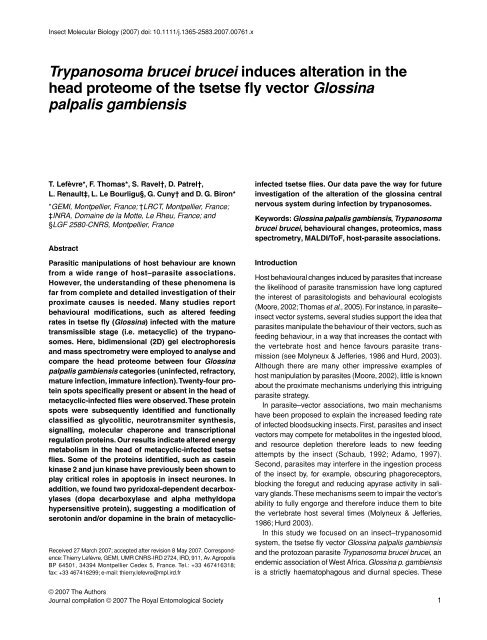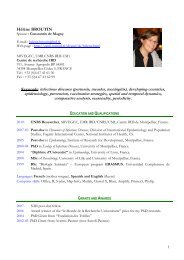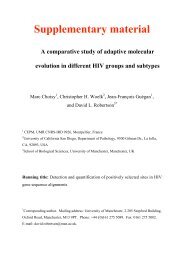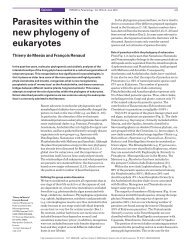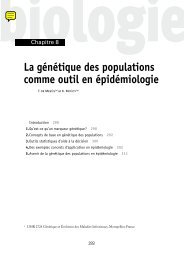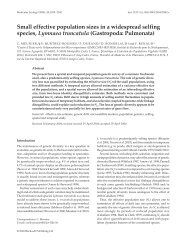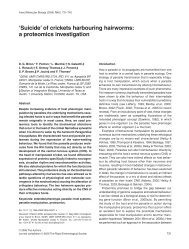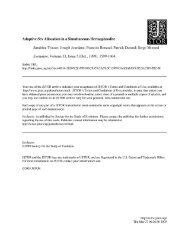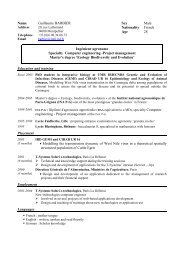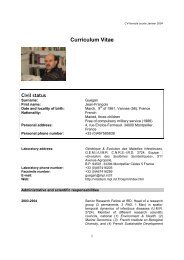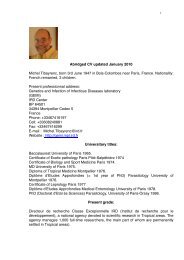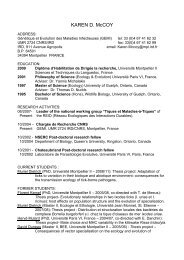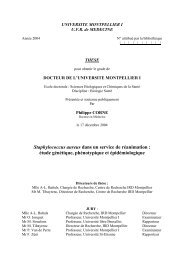Trypanosoma brucei brucei induces alteration in the head ... - IRD
Trypanosoma brucei brucei induces alteration in the head ... - IRD
Trypanosoma brucei brucei induces alteration in the head ... - IRD
You also want an ePaper? Increase the reach of your titles
YUMPU automatically turns print PDFs into web optimized ePapers that Google loves.
Insect Molecular Biology (2007) doi: 10.1111/j.1365-2583.2007.00761.x<br />
<strong>Trypanosoma</strong> <strong>brucei</strong> <strong>brucei</strong> <strong><strong>in</strong>duces</strong> <strong>alteration</strong> <strong>in</strong> <strong>the</strong><br />
Blackwell Publish<strong>in</strong>g Ltd<br />
<strong>head</strong> proteome of <strong>the</strong> tsetse fly vector Gloss<strong>in</strong>a<br />
palpalis gambiensis<br />
T. Lefèvre*, F. Thomas*, S. Ravel†, D. Patrel†,<br />
L. Renault‡, L. Le Bourligu§, G. Cuny† and D. G. Biron*<br />
*GEMI, Montpellier, France; †LRCT, Montpellier, France;<br />
‡INRA, Doma<strong>in</strong>e de la Motte, Le Rheu, France; and<br />
§LGF 2580-CNRS, Montpellier, France<br />
Abstract<br />
Received 27 March 2007; accepted after revision 8 May 2007. Correspondence:<br />
Thierry Lefèvre, GEMI, UMR CNRS-<strong>IRD</strong> 2724, <strong>IRD</strong>, 911, Av. Agropolis<br />
BP 64501, 34394 Montpellier Cedex 5, France. Tel.: +33 467416318;<br />
fax: +33 467416299; e-mail: thierry.lefevre@mpl.ird.fr<br />
Parasitic manipulations of host behaviour are known<br />
from a wide range of host–parasite associations.<br />
However, <strong>the</strong> understand<strong>in</strong>g of <strong>the</strong>se phenomena is<br />
far from complete and detailed <strong>in</strong>vestigation of <strong>the</strong>ir<br />
proximate causes is needed. Many studies report<br />
behavioural modifications, such as altered feed<strong>in</strong>g<br />
rates <strong>in</strong> tsetse fly (Gloss<strong>in</strong>a) <strong>in</strong>fected with <strong>the</strong> mature<br />
transmissible stage (i.e. metacyclic) of <strong>the</strong> trypanosomes.<br />
Here, bidimensional (2D) gel electrophoresis<br />
and mass spectrometry were employed to analyse and<br />
compare <strong>the</strong> <strong>head</strong> proteome between four Gloss<strong>in</strong>a<br />
palpalis gambiensis categories (un<strong>in</strong>fected, refractory,<br />
mature <strong>in</strong>fection, immature <strong>in</strong>fection). Twenty-four prote<strong>in</strong><br />
spots specifically present or absent <strong>in</strong> <strong>the</strong> <strong>head</strong> of<br />
metacyclic-<strong>in</strong>fected flies were observed. These prote<strong>in</strong><br />
spots were subsequently identified and functionally<br />
classified as glycolitic, neurotransmiter syn<strong>the</strong>sis,<br />
signall<strong>in</strong>g, molecular chaperone and transcriptional<br />
regulation prote<strong>in</strong>s. Our results <strong>in</strong>dicate altered energy<br />
metabolism <strong>in</strong> <strong>the</strong> <strong>head</strong> of metacyclic-<strong>in</strong>fected tsetse<br />
flies. Some of <strong>the</strong> prote<strong>in</strong>s identified, such as case<strong>in</strong><br />
k<strong>in</strong>ase 2 and jun k<strong>in</strong>ase have previously been shown to<br />
play critical roles <strong>in</strong> apoptosis <strong>in</strong> <strong>in</strong>sect neurones. In<br />
addition, we found two pyridoxal-dependent decarboxylases<br />
(dopa decarboxylase and alpha methyldopa<br />
hypersensitive prote<strong>in</strong>), suggest<strong>in</strong>g a modification of<br />
seroton<strong>in</strong> and/or dopam<strong>in</strong>e <strong>in</strong> <strong>the</strong> bra<strong>in</strong> of metacyclic<strong>in</strong>fected<br />
tsetse flies. Our data pave <strong>the</strong> way for future<br />
<strong>in</strong>vestigation of <strong>the</strong> <strong>alteration</strong> of <strong>the</strong> gloss<strong>in</strong>a central<br />
nervous system dur<strong>in</strong>g <strong>in</strong>fection by trypanosomes.<br />
Keywords: Gloss<strong>in</strong>a palpalis gambiensis, <strong>Trypanosoma</strong><br />
<strong>brucei</strong> <strong>brucei</strong>, behavioural changes, proteomics, mass<br />
spectrometry, MALDI/ToF, host-parasite associations.<br />
Introduction<br />
Host behavioural changes <strong>in</strong>duced by parasites that <strong>in</strong>crease<br />
<strong>the</strong> likelihood of parasite transmission have long captured<br />
<strong>the</strong> <strong>in</strong>terest of parasitologists and behavioural ecologists<br />
(Moore, 2002; Thomas et al., 2005). For <strong>in</strong>stance, <strong>in</strong> parasite–<br />
<strong>in</strong>sect vector systems, several studies support <strong>the</strong> idea that<br />
parasites manipulate <strong>the</strong> behaviour of <strong>the</strong>ir vectors, such as<br />
feed<strong>in</strong>g behaviour, <strong>in</strong> a way that <strong>in</strong>creases <strong>the</strong> contact with<br />
<strong>the</strong> vertebrate host and hence favours parasite transmission<br />
(see Molyneux & Jefferies, 1986 and Hurd, 2003).<br />
Although <strong>the</strong>re are many o<strong>the</strong>r impressive examples of<br />
host manipulation by parasites (Moore, 2002), little is known<br />
about <strong>the</strong> proximate mechanisms underly<strong>in</strong>g this <strong>in</strong>trigu<strong>in</strong>g<br />
parasite strategy.<br />
In parasite–vector associations, two ma<strong>in</strong> mechanisms<br />
have been proposed to expla<strong>in</strong> <strong>the</strong> <strong>in</strong>creased feed<strong>in</strong>g rate<br />
of <strong>in</strong>fected bloodsuck<strong>in</strong>g <strong>in</strong>sects. First, parasites and <strong>in</strong>sect<br />
vectors may compete for metabolites <strong>in</strong> <strong>the</strong> <strong>in</strong>gested blood,<br />
and resource depletion <strong>the</strong>refore leads to new feed<strong>in</strong>g<br />
attempts by <strong>the</strong> <strong>in</strong>sect (Schaub, 1992; Adamo, 1997).<br />
Second, parasites may <strong>in</strong>terfere <strong>in</strong> <strong>the</strong> <strong>in</strong>gestion process<br />
of <strong>the</strong> <strong>in</strong>sect by, for example, obscur<strong>in</strong>g phagoreceptors,<br />
block<strong>in</strong>g <strong>the</strong> foregut and reduc<strong>in</strong>g apyrase activity <strong>in</strong> salivary<br />
glands. These mechanisms seem to impair <strong>the</strong> vector’s<br />
ability to fully engorge and <strong>the</strong>refore <strong>in</strong>duce <strong>the</strong>m to bite<br />
<strong>the</strong> vertebrate host several times (Molyneux & Jefferies,<br />
1986; Hurd 2003).<br />
In this study we focused on an <strong>in</strong>sect–trypanosomid<br />
system, <strong>the</strong> tsetse fly vector Gloss<strong>in</strong>a palpalis gambiensis<br />
and <strong>the</strong> protozoan parasite <strong>Trypanosoma</strong> <strong>brucei</strong> <strong>brucei</strong>, an<br />
endemic association of West Africa. Gloss<strong>in</strong>a p. gambiensis<br />
is a strictly haematophagous and diurnal species. These<br />
© 2007 The Authors<br />
Journal compilation © 2007 The Royal Entomological Society 1
2 T. Lefèvre et al.<br />
flies are found <strong>in</strong> dense, wet equatorial ra<strong>in</strong> forest and <strong>in</strong><br />
local patches of dense vegetation along <strong>the</strong> banks of rivers<br />
and lakes <strong>in</strong> arid regions. <strong>Trypanosoma</strong> b. <strong>brucei</strong> is <strong>the</strong><br />
causative agent of Nagana, a serious animal parasitic disease<br />
<strong>in</strong> sub-Saharan African countries. The life cycle of this<br />
trypanosome <strong>in</strong>volves several different stages <strong>in</strong> <strong>the</strong> <strong>in</strong>sect<br />
vector and <strong>the</strong> mammalian host. The parasite multiplies as<br />
procyclic forms <strong>in</strong> <strong>the</strong> midgut of <strong>the</strong> <strong>in</strong>sect and <strong>the</strong> <strong>in</strong>fection<br />
of <strong>the</strong> mammalian host occurs when <strong>the</strong> <strong>in</strong>sect vector<br />
conta<strong>in</strong><strong>in</strong>g <strong>the</strong> metacyclic stages <strong>in</strong> its salivary glands<br />
feeds upon <strong>the</strong> host.<br />
In tsetse flies parasitized with trypanosomes, Jenni et al.<br />
(1980) showed that Gloss<strong>in</strong>a morsitans morsitans <strong>in</strong>fected<br />
with T. <strong>brucei</strong> probed three times more often and fed more<br />
voraciously than un<strong>in</strong>fected flies. Work<strong>in</strong>g on G. m. morsitans<br />
<strong>in</strong>fected with T. congolense, Roberts (1981) reported that<br />
<strong>in</strong>fected flies probed significantly more frequently and took<br />
longer to engorge than un<strong>in</strong>fected flies. The <strong>in</strong>creased<br />
prob<strong>in</strong>g may be <strong>the</strong> result of parasites physically <strong>in</strong>terfer<strong>in</strong>g<br />
with phagoreceptors <strong>in</strong> <strong>the</strong> tsetse fly labrum (Molyneux<br />
et al., 1979; Jenni et al., 1980; Livesey et al., 1980, Thevenaz<br />
& Hecker, 1980). However, such f<strong>in</strong>d<strong>in</strong>gs have not been<br />
confirmed by studies performed by Moloo’s group (Moloo,<br />
1983; Moloo & Dar, 1985; Makumi & Moloo, 1991).<br />
The central nervous system (CNS) functions to convert<br />
patterns of activity <strong>in</strong> sensory receptors <strong>in</strong>to patterns of<br />
muscle activity that constitute appropriate behaviour. Thus,<br />
any changes <strong>in</strong> behaviour must have a molecular basis <strong>in</strong> <strong>the</strong><br />
CNS (Adamo, 1997, 2002; Hamilton & Hurd, 2002). Explor<strong>in</strong>g<br />
this molecular basis will undoubtedly help <strong>in</strong> elucidat<strong>in</strong>g<br />
just how pathogens manipulate <strong>the</strong> behaviour of <strong>the</strong>ir <strong>in</strong>sect<br />
vector (Lefèvre et al., 2006). As part of our efforts to ga<strong>in</strong><br />
a broader understand<strong>in</strong>g of <strong>the</strong> proximate causes of <strong>the</strong><br />
behavioural changes observed <strong>in</strong> <strong>in</strong>fected tsetse flies, and<br />
as a first step toward decipher<strong>in</strong>g <strong>the</strong> bra<strong>in</strong> molecular<br />
mechanisms <strong>in</strong>volved, we <strong>in</strong>vestigated <strong>the</strong> bra<strong>in</strong> proteome<br />
of metacyclic-<strong>in</strong>fected Gloss<strong>in</strong>a. Proteomics, which allows<br />
<strong>in</strong>vestigation of <strong>the</strong> translation of genomic <strong>in</strong>formation, offers<br />
an approach to study<strong>in</strong>g <strong>the</strong> global changes <strong>in</strong> prote<strong>in</strong><br />
expression of <strong>the</strong> <strong>in</strong>sect host CNS caused by parasites<br />
(Biron et al., 2005a, 2006; Ponton et al., 2006; Lefèvre et al.,<br />
2007). Here, we used such an approach on <strong>the</strong> G. p.<br />
gambiensis–T. b. <strong>brucei</strong> system to elucidate molecular<br />
mechanisms <strong>in</strong> <strong>the</strong> bra<strong>in</strong> that underlie behavioural<br />
modifications.<br />
Us<strong>in</strong>g bidimensional gel electrophoresis (2-DE) coupled<br />
with mass spectrometry, <strong>the</strong> current study aimed to compare<br />
<strong>the</strong> CNS proteome <strong>in</strong> four groups of Gloss<strong>in</strong>a: (1) with<br />
mature <strong>in</strong>fection (M): i.e. <strong>the</strong> parasite is present <strong>in</strong> <strong>the</strong> midgut<br />
and <strong>in</strong> <strong>the</strong> salivary glands, characteris<strong>in</strong>g <strong>in</strong>fective flies;<br />
(2) with immature <strong>in</strong>fection (I): i.e. <strong>the</strong> parasite is only localised<br />
<strong>in</strong> <strong>the</strong> midgut; (3) refractory (R): i.e. <strong>the</strong> parasite was elim<strong>in</strong>ated<br />
<strong>in</strong> <strong>the</strong> days follow<strong>in</strong>g <strong>the</strong> <strong>in</strong>fective bloodmeal; and (4) un<strong>in</strong>fected<br />
(C): i.e. flies fed with un<strong>in</strong>fective bloodmeal. The I and R<br />
Figure 1. (A) Host proteome response: number of common prote<strong>in</strong> spots<br />
(above diagonal) and proteome distances (below diagonal) between<br />
categories: Control (C) (Un<strong>in</strong>fected flies), Mature <strong>in</strong>fection (M), Immature<br />
<strong>in</strong>fection (I) and Refractory flies (R). (B) Classification of 2D gels result<strong>in</strong>g<br />
from <strong>the</strong> proteome distance among <strong>the</strong> four fly categories.<br />
groups were used as secondary controls to exclude prote<strong>in</strong>s<br />
that are nonspecific to mature <strong>in</strong>fections and hence<br />
unlikely to be l<strong>in</strong>ked with behavioural changes (Biron et al.,<br />
2005b). More specifically, we address <strong>the</strong> follow<strong>in</strong>g questions:<br />
(1) Do <strong>the</strong> trypanosomes modify <strong>the</strong> bra<strong>in</strong> proteome<br />
of <strong>the</strong> <strong>in</strong>sect vector? (2) If yes, what is <strong>the</strong> function of <strong>the</strong><br />
prote<strong>in</strong>s differentially expressed <strong>in</strong> <strong>the</strong> bra<strong>in</strong> of mature<br />
<strong>in</strong>fected flies and hence what are <strong>the</strong> molecular pathways<br />
thus altered?<br />
Results<br />
Mortality and <strong>in</strong>fection rates<br />
The mortality rate was 20% for <strong>the</strong> un<strong>in</strong>fected group<br />
(C; n = 20) and 18.9% for <strong>the</strong> <strong>in</strong>fected groups (M + I + R;<br />
n = 159). The rate of midgut <strong>in</strong>fection was 13% and <strong>the</strong> rate<br />
of mature <strong>in</strong>fection <strong>in</strong> <strong>the</strong> salivary glands was 5.2%.<br />
Heuristic classification of 2-DE gels<br />
Figure 1 <strong>in</strong>dicates <strong>the</strong> number of common prote<strong>in</strong> spots<br />
resolved along with <strong>the</strong> proteome distances among <strong>the</strong> four<br />
<strong>head</strong> categories (Nei & Li, 1979). The qualitative data<br />
(presence/absence of prote<strong>in</strong> spots) were analysed with a<br />
© 2007 The Authors<br />
Journal compilation © 2007 The Royal Entomological Society, doi: 10.1111/j.1365-2583.2007.00761.x
Head proteome <strong>alteration</strong> <strong>in</strong> <strong>Trypanosoma</strong>-<strong>in</strong>fected Gloss<strong>in</strong>a 3<br />
Table 1. Number of prote<strong>in</strong> spots present or absent (not detected) dur<strong>in</strong>g<br />
host-parasite <strong>in</strong>teraction. Control (un<strong>in</strong>fected flies) (C), mature <strong>in</strong>fection (M),<br />
immature <strong>in</strong>fection (I), refractory flies (R)<br />
Biological <strong>in</strong>terpretation C M I R<br />
always expressed (common prote<strong>in</strong> spots) × × × × 613<br />
Mature <strong>in</strong>fection (behavioural modifications) × 12<br />
× × × 12<br />
Resistance × 24<br />
× × × 5<br />
Parasite contact × × × 24<br />
× 50<br />
Immature <strong>in</strong>fection × 11<br />
× × × 11<br />
Successful <strong>in</strong>fection × × 10<br />
× × 30<br />
Unknown × × 10<br />
× × 1<br />
× × 3<br />
Total 816<br />
Number of<br />
prote<strong>in</strong> spots<br />
Note: X: prote<strong>in</strong> spots present; blank: prote<strong>in</strong> spots absent (not detected).<br />
phenetic study by calculat<strong>in</strong>g <strong>the</strong> ‘proteome distance’. The<br />
dendogram constructed (Fig. 1B) <strong>in</strong>dicates that <strong>the</strong> categories<br />
of flies fed with an <strong>in</strong>fected bloodmeal (i.e. M, I and R)<br />
jo<strong>in</strong> toge<strong>the</strong>r, whereas <strong>the</strong> C category is isolated. Fur<strong>the</strong>rmore,<br />
among <strong>the</strong> categories of flies fed with an <strong>in</strong>fected<br />
bloodmeal, <strong>the</strong> two <strong>in</strong>fected (M and I) jo<strong>in</strong> toge<strong>the</strong>r,<br />
whereas <strong>the</strong> R category is isolated.<br />
Analysis of 2-DE gels<br />
Table 1 shows <strong>the</strong> number of prote<strong>in</strong> spots present or<br />
absent (i.e. not detectable: break-even po<strong>in</strong>t of detection)<br />
<strong>in</strong> <strong>the</strong> four categories. Six hundred and thirteen prote<strong>in</strong><br />
spots were common to <strong>the</strong> four categories whilst 24 were<br />
specifically present or absent from <strong>the</strong> M category. These<br />
24 spots characterize <strong>the</strong> mature <strong>in</strong>fection <strong>in</strong> <strong>the</strong> <strong>head</strong> of<br />
Gloss<strong>in</strong>a and are thus potentially <strong>in</strong>volved <strong>in</strong> behavioural<br />
modifications. In addition, prote<strong>in</strong> spots specific to <strong>the</strong> three<br />
o<strong>the</strong>r categories were revealed (see Table 1). Figure 2 shows<br />
<strong>the</strong> syn<strong>the</strong>tic gel and highlights <strong>the</strong> 24 prote<strong>in</strong> spots of <strong>in</strong>terest<br />
(i.e. specifically present or absent <strong>in</strong> M) as well as common<br />
and prote<strong>in</strong> spots that are nonspecific to mature <strong>in</strong>fection.<br />
Identification<br />
Figure 2. Two-dimensional syn<strong>the</strong>tic gel show<strong>in</strong>g <strong>the</strong> <strong>head</strong> proteome of<br />
Gloss<strong>in</strong>a palpalis gambiensis <strong>in</strong> response to <strong>in</strong>fection by <strong>Trypanosoma</strong><br />
<strong>brucei</strong> <strong>brucei</strong>. • Common and ‘nonspecific’ prote<strong>in</strong> spots. • Prote<strong>in</strong>s<br />
specifically present <strong>in</strong> <strong>the</strong> <strong>head</strong> proteome of mature <strong>in</strong>fection (M) flies.<br />
Common and ‘non specific’ prote<strong>in</strong> spots. Prote<strong>in</strong>s specifically<br />
present <strong>in</strong> <strong>the</strong> <strong>head</strong> proteome of mature <strong>in</strong>fection (M) flies. Prote<strong>in</strong>s<br />
specifically miss<strong>in</strong>g <strong>in</strong> <strong>the</strong> <strong>head</strong> proteome of M flies.<br />
To ref<strong>in</strong>e our studies on <strong>the</strong> molecular mechanisms <strong>in</strong>volved<br />
<strong>in</strong> <strong>the</strong> modification of host behaviour, we attempted to identify<br />
<strong>the</strong> 24 prote<strong>in</strong> spots of <strong>in</strong>terest <strong>in</strong> available onl<strong>in</strong>e SwissProt/<br />
TrEMBL prote<strong>in</strong> database (http://expasy.org/sprot/). Of<br />
<strong>the</strong> 24 prote<strong>in</strong> spots of <strong>in</strong>terest, 17 were identified through<br />
peptide mass f<strong>in</strong>gerpr<strong>in</strong>t<strong>in</strong>g. The results are summarized <strong>in</strong><br />
Table 2. The identified prote<strong>in</strong>s can be functionally classified<br />
as glycolytic, neurotransmitter syn<strong>the</strong>sis, molecular<br />
chaperone, signall<strong>in</strong>g and transcriptional regulatory prote<strong>in</strong>s<br />
(see Table 2). One prote<strong>in</strong> (Table 2, spot 17) has miscellaneous<br />
functions whilst four prote<strong>in</strong>s have unknown functions<br />
and have thus not been functionally classified (Table 2,<br />
spots 4, 5, 9 and 23).<br />
Glycolysis. Three glycolytic enzymes with altered levels <strong>in</strong><br />
<strong>the</strong> <strong>head</strong> of flies with mature <strong>in</strong>fection were found: enolase was<br />
present <strong>in</strong> <strong>the</strong> M group, whereas two glucose-6-phosphate<br />
1-dehydrogenases were specifically absent <strong>in</strong> <strong>the</strong> M group.<br />
The prote<strong>in</strong> functions are <strong>in</strong>dicated <strong>in</strong> Table 2.<br />
Neurotransmitter syn<strong>the</strong>sis. Two neurotransmitter enzymes<br />
were found: dopa decarboxylase (DDC; spot 11, specifically<br />
absent <strong>in</strong> M group) and alpha methyldopa hypersensitive<br />
prote<strong>in</strong> (spot 14, specifically present <strong>in</strong> M group). Both<br />
prote<strong>in</strong>s are pyridoxal-dependent decarboxylases. DDC,<br />
also known as aromatic L-am<strong>in</strong>o decarboxylase, catalyses<br />
<strong>the</strong> f<strong>in</strong>al step (decarboxylation) <strong>in</strong> <strong>the</strong> syn<strong>the</strong>sis of dopam<strong>in</strong>e<br />
and seroton<strong>in</strong>. The α-methyldopa hypersensitive gene <strong>in</strong><br />
Drosophila arose from DDC duplication, and is closely<br />
l<strong>in</strong>ked to DDC (Eveleth & Marsh, 1986).<br />
Signall<strong>in</strong>g. Five signall<strong>in</strong>g prote<strong>in</strong>s were found to be differentially<br />
expressed <strong>in</strong> <strong>the</strong> M group (specifically present or<br />
absent). One prote<strong>in</strong> (spot 1), conta<strong>in</strong><strong>in</strong>g a C2 doma<strong>in</strong>, was<br />
absent <strong>in</strong> <strong>the</strong> M group. In contrast, two prote<strong>in</strong> k<strong>in</strong>ases [spot<br />
15, jun k<strong>in</strong>ase (JNK) and spot 21, case<strong>in</strong> k<strong>in</strong>ase 2 (CK2)] were<br />
present <strong>in</strong> <strong>the</strong> M group. Lastly, two prote<strong>in</strong>s conta<strong>in</strong><strong>in</strong>g a<br />
Masterm<strong>in</strong>d (MAM) doma<strong>in</strong> (spots 2, 6) were identified as<br />
absent <strong>in</strong> <strong>the</strong> M group. Prote<strong>in</strong> functions are given <strong>in</strong> Table 2.<br />
© 2007 The Authors<br />
Journal compilation © 2007 The Royal Entomological Society, doi: 10.1111/j.1365-2583.2007.00761.x
© 2007 The Authors<br />
Journal compilation © 2007 The Royal Entomological Society, doi: 10.1111/j.1365-2583.2007.00761.x<br />
Table 2. Mass spectrometric identification of prote<strong>in</strong> spots present or absent <strong>in</strong> <strong>the</strong> <strong>head</strong> of flies with mature <strong>in</strong>fection (M category) and functions of <strong>the</strong> identified prote<strong>in</strong>s<br />
Spot no.*<br />
Presence (P)<br />
Absence (A)<br />
<strong>in</strong> M group<br />
(Access no.)†/Name of prote<strong>in</strong><br />
(exp Mw-exp pI)/<br />
(thMw-thIp)<br />
Coverage (%)<br />
(P-value) Doma<strong>in</strong>, Family‡ Functional class§ Description and biological processes§<br />
7<br />
12<br />
A<br />
A<br />
(Q5TUJ4) ENSANGP00000028421<br />
(Fragment)<br />
(Q7QLH1) ENSANGP00000012074<br />
(40;7.07)/(36;6.82)<br />
(46;5.98)/(55;6.48)<br />
23 (2.5e-6)<br />
25 (7.5e-7)<br />
G6PD_C glycolysis Glucose-6-phosphate 1-dehydrogenase<br />
catalyses <strong>the</strong> first step <strong>in</strong> <strong>the</strong> pentose<br />
pathway, i.e. <strong>the</strong> conversion of glucose-<br />
(Fragment)<br />
6-phosphate to gluconolactone 6-phosphate<br />
<strong>in</strong> <strong>the</strong> presence of NADP, produc<strong>in</strong>g NADPH.<br />
18 P (Q32ZR3) Enolase (Fragment) (30;5.59)/(24;5.27) 24 (3.1e-5) Enolase Enolase catalyses <strong>the</strong> <strong>in</strong>terconversion of<br />
2-phosphoglycerate and phosphoenolpyruvate<br />
<strong>in</strong> <strong>the</strong> pentose pathway.<br />
11 A (Q402L7) Dopa decarboxylase (50;6.38)/(54;6.05) 16 (1.9e-7) Pyridoxal_deC Neurotransmitter syn<strong>the</strong>sis This prote<strong>in</strong> family catalyses <strong>the</strong> decarboxylation<br />
14 P (Q8WSE8) Alpha methyldopa (50;5.78)/(38;5.85) 18 (1.9e-5)<br />
of L dopa to dopam<strong>in</strong> and L hydroxytryptophan<br />
hypersensitive prote<strong>in</strong> (Fragment)<br />
to seroton<strong>in</strong>.<br />
3 A (Q9VL02) CG5395-PA (GH08677p) (43;6.82)/(42;8.30) 19 (1.4e-5) AAA Molecular chaperone A class of chaperone like ATPase <strong>in</strong>volved<br />
<strong>in</strong> assembly, operation, and disassembly<br />
of prote<strong>in</strong> complexes.<br />
15 P (O61444) Stress activated MAP<br />
k<strong>in</strong>ase k<strong>in</strong>ase 4<br />
(44;6.89)/(48;7.11) 21 (4.2e-5) Pk<strong>in</strong>ase Jun k<strong>in</strong>ase (JNK) also known as stress-activated<br />
prote<strong>in</strong> belongs to <strong>the</strong> MAP k<strong>in</strong>ase prote<strong>in</strong>s. JNK<br />
activates <strong>the</strong> transcription factor c-Jun by<br />
phosphorylat<strong>in</strong>g ser<strong>in</strong>e 63 and 73<br />
21 P (O76485) Case<strong>in</strong> k<strong>in</strong>ase II subunit beta (32;6.79)/(25;5.55) 24 (5.6e-4) CK_II_beta Regulatory beta subunit of prote<strong>in</strong> case<strong>in</strong> k<strong>in</strong>ase<br />
2 (CK2), a Ser–Thr prote<strong>in</strong> k<strong>in</strong>ase. Catalyses <strong>the</strong><br />
phosphorylation of many prote<strong>in</strong>s required for<br />
signal transduction, cell-cycle regulation,<br />
DNA metabolism<br />
1 A (Q7PEL9) ENSANGP00000024306<br />
(Fragment)<br />
(54;6.34)/(41;6.10) 23 (2.1e-5) C2 Signall<strong>in</strong>g Doma<strong>in</strong> found <strong>in</strong> many prote<strong>in</strong>s most notably<br />
prote<strong>in</strong> k<strong>in</strong>ase. The C2 doma<strong>in</strong> is thought to be<br />
<strong>in</strong>volved <strong>in</strong> calcium-dependent phospholipid<br />
b<strong>in</strong>d<strong>in</strong>g.<br />
2 A (Q5ELK4) SR-CIV (53;5.61)/(46;5.63) 20 (1.4e-6) MAM An extracellular doma<strong>in</strong> found <strong>in</strong> many receptors.<br />
6 A (Q6V6Q8) CG3212 (Fragment) (28;4.57)/(26;5.86) 23 (5.6e-6)<br />
Prote<strong>in</strong>s conta<strong>in</strong><strong>in</strong>g <strong>the</strong> MAM doma<strong>in</strong> have a modular,<br />
receptor-like architecture compris<strong>in</strong>g a signal peptide,<br />
an N-term<strong>in</strong>al extracellular doma<strong>in</strong>, a s<strong>in</strong>gle<br />
transmembrane doma<strong>in</strong> and an <strong>in</strong>tracellular doma<strong>in</strong>.<br />
The MAM doma<strong>in</strong> is thought to have an adhesive<br />
function. Spot 2 is <strong>the</strong> SR-CIV prote<strong>in</strong><br />
(class C scavenger receptor)<br />
24 P (Q5TMQ2) ENSANGP00000026400<br />
(Fragment)<br />
17 P (Q5TTZ2) ENSANGP00000027149<br />
(Fragment)<br />
(31;4.61)/(26;5.58) 25 (3.0e-7) Znf_C2H2 Transcriptional regulation The C2H2 z<strong>in</strong>c f<strong>in</strong>ger is <strong>the</strong> classical z<strong>in</strong>c f<strong>in</strong>ger<br />
doma<strong>in</strong>: <strong>the</strong> two conserved cyste<strong>in</strong>es and histid<strong>in</strong>es<br />
co-ord<strong>in</strong>ate a z<strong>in</strong>c ion. Z<strong>in</strong>c f<strong>in</strong>ger motifs are nucleic<br />
acid-b<strong>in</strong>d<strong>in</strong>g prote<strong>in</strong> structures.<br />
(26;5.35)/(24;5.31) 26 (1.3e-6) concanaval<strong>in</strong> A-like Miscellaneous Members of this family are diverse, and <strong>in</strong>clude<br />
<strong>the</strong> lect<strong>in</strong>s, glucanases, xylanases, pentrax<strong>in</strong>s<br />
and calnex<strong>in</strong>s There are also many Con A-like<br />
doma<strong>in</strong>s found <strong>in</strong> prote<strong>in</strong>s <strong>in</strong>volved <strong>in</strong> cell<br />
recognition and adhesion (i.e. neurex<strong>in</strong>s)<br />
4 T. Lefèvre et al.
Head proteome <strong>alteration</strong> <strong>in</strong> <strong>Trypanosoma</strong>-<strong>in</strong>fected Gloss<strong>in</strong>a 5<br />
Table 2. (Cont<strong>in</strong>ued)<br />
Coverage (%)<br />
(P-value) Doma<strong>in</strong>, Family‡ Functional class§ Description and biological processes§<br />
(exp Mw-exp pI)/<br />
(thMw-thIp)<br />
Presence (P)<br />
Absence (A)<br />
<strong>in</strong> M group (Access no.)†/Name of prote<strong>in</strong><br />
Spot no.*<br />
4 A (Q9V351) CG11191-PA (GH10486p) (41;6.7)/(38;5.85) 26 (3.6e-5)<br />
5 A (Q7QB97) ENSANGP00000020477 (35;6.52)/(29;6.65) 21 (3.4e-6) Unknown<br />
9 A (Q9VS59) CG8580-PA, isoform A (32;7.54)/(22;9.21) 33 (1.7e-8)<br />
23 P (Q6V4B5) IKKgamma (Fragment) (43;5.69)/(31;4.79) 18 (3.5e-5)<br />
Note: *‘Spot no.’ refers to prote<strong>in</strong> spots on 2D gel <strong>in</strong> Fig. 2. †‘Access no.’ refers to <strong>the</strong> accession number <strong>in</strong> <strong>the</strong> SWISS-PROT and TrEMBL prote<strong>in</strong> databases (http://www.expasy.org/). ‡‘Family’ <strong>in</strong>dicates <strong>the</strong> prote<strong>in</strong><br />
family or doma<strong>in</strong> accord<strong>in</strong>g to <strong>the</strong> PFAM database of <strong>the</strong> Sanger Institute (http://www.sanger.ac.uk/Software/Pfam/) or <strong>the</strong> InterPro database of <strong>the</strong> European Bio<strong>in</strong>formatics Institute (http://www.ebi.ac.uk/<strong>in</strong>terpro/).<br />
Association of each prote<strong>in</strong> with functional class and biological processes have been determ<strong>in</strong>ed by <strong>the</strong> gene ontology database (http://www.geneontology.org/) and a literature search.<br />
Heat shock response. One identified protease, which was<br />
absent <strong>in</strong> <strong>the</strong> M group, is a chaperone-like ATPase associated<br />
with <strong>the</strong> assembly, operation and disassembly of prote<strong>in</strong><br />
complexes (see Neuwald et al., 1999 for a review).<br />
Regulation of gene expression. Many prote<strong>in</strong>s, most notably<br />
transcriptional regulators, conta<strong>in</strong> multiple ‘Z<strong>in</strong>c f<strong>in</strong>ger’<br />
doma<strong>in</strong>s that are nucleic acid-b<strong>in</strong>d<strong>in</strong>g prote<strong>in</strong> structures.These<br />
transcription factors, which can behave as activators or<br />
repressors, b<strong>in</strong>d to sequences present <strong>in</strong> <strong>the</strong> promoters of<br />
genes encod<strong>in</strong>g, for example, cell-cycle regulators, MAP<br />
k<strong>in</strong>ases, regulatory GTPases, histones, enzymes <strong>in</strong>volved<br />
<strong>in</strong> DNA syn<strong>the</strong>sis and growth factors. Here we show that<br />
as regulatory prote<strong>in</strong> conta<strong>in</strong><strong>in</strong>g a ‘Z<strong>in</strong>c F<strong>in</strong>ger’ doma<strong>in</strong><br />
(spot 24) is specifically present <strong>in</strong> <strong>the</strong> M group.<br />
Miscellaneous: As mentioned earlier, one prote<strong>in</strong> present<br />
<strong>in</strong> <strong>the</strong> M group has miscellaneous functions and was thus<br />
not functionally classified (spot 17, Table 2).<br />
Discussion<br />
To date, noth<strong>in</strong>g has been published concern<strong>in</strong>g <strong>the</strong> CNS<br />
function<strong>in</strong>g of tsetse flies <strong>in</strong>fected with trypanosomes.<br />
The present study is <strong>the</strong> first to explore <strong>the</strong> possibility that<br />
molecular changes operate <strong>in</strong> <strong>the</strong> bra<strong>in</strong> of tsetse flies dur<strong>in</strong>g<br />
<strong>in</strong>fection with trypanosomes. Us<strong>in</strong>g 2-DE coupled with<br />
mass spectrometry, we show that proteomics tools are<br />
sensitive enough to detect <strong>in</strong>traspecific proteome variations<br />
l<strong>in</strong>ked to parasitic status and even to parasite stage (i.e.<br />
mature versus immature <strong>in</strong>fection). Our proteomics analysis<br />
revealed prote<strong>in</strong>s with an altered level <strong>in</strong> <strong>the</strong> <strong>head</strong> of<br />
metacyclic <strong>in</strong>fected flies and thus that are potentially<br />
<strong>in</strong>volved <strong>in</strong> behavioural manipulation. These candidate prote<strong>in</strong>s<br />
are known to play crucial roles <strong>in</strong> metabolism, cellular<br />
signall<strong>in</strong>g pathways, neurotransmitter syn<strong>the</strong>sis, transcriptional<br />
regulation and <strong>in</strong> heat shock responses.<br />
Altered energy metabolism<br />
Three glycolytic enzymes have been found to be differentially<br />
expressed (present or absent) suggest<strong>in</strong>g <strong>alteration</strong>s <strong>in</strong><br />
energy metabolism. Glucose is <strong>the</strong> major substrate utilized<br />
for bra<strong>in</strong> metabolism (Hertz & Dienel, 2002; Ikemoto et al.,<br />
2003) and <strong>the</strong> glycolytic pathway is essential for ma<strong>in</strong>ta<strong>in</strong><strong>in</strong>g<br />
normal bra<strong>in</strong> and neuronal functions <strong>in</strong> vertebrates<br />
and <strong>in</strong>vertebrates (Ames, 2000; Ikemoto et al., 2003). For<br />
<strong>in</strong>stance, <strong>alteration</strong> of bra<strong>in</strong> metabolic activity is one of <strong>the</strong><br />
causes of numerous neurological disorders and glycolytic<br />
enzymes described here have been shown to be <strong>in</strong>volved<br />
<strong>in</strong> schizophrenia (Prabakaran et al., 2004) and Alzheimer’s<br />
disease <strong>in</strong> humans (Bigl et al., 1999). Beyond <strong>the</strong> potential<br />
<strong>in</strong>direct role of altered metabolism on behaviour, an alternative<br />
hypo<strong>the</strong>sis is that <strong>the</strong> parasite <strong><strong>in</strong>duces</strong> a nutritional<br />
stress associated with a global metabolism disorder <strong>in</strong> several<br />
© 2007 The Authors<br />
Journal compilation © 2007 The Royal Entomological Society, doi: 10.1111/j.1365-2583.2007.00761.x
6 T. Lefèvre et al.<br />
tissues (i.e. not only <strong>in</strong> <strong>the</strong> bra<strong>in</strong>) that leads secondarily to<br />
new feed<strong>in</strong>g attempts. Alteration <strong>in</strong> energy metabolism has<br />
been shown recently <strong>in</strong> ano<strong>the</strong>r <strong>in</strong>sect vector–pathogen<br />
system, Anopheles mosquito–Plasmodium (Lefèvre et al.,<br />
2007). Taken toge<strong>the</strong>r, <strong>the</strong>se f<strong>in</strong>d<strong>in</strong>gs provide substantial<br />
evidence of metabolic disturbance <strong>in</strong> <strong>the</strong> bra<strong>in</strong> of <strong>in</strong>fected<br />
vectors and warrant fur<strong>the</strong>r <strong>in</strong>vestigation <strong>in</strong>to <strong>the</strong> effects<br />
of this phenomenon on vector feed<strong>in</strong>g behaviour.<br />
Altered signal transduction<br />
Several prote<strong>in</strong>s described here conta<strong>in</strong> doma<strong>in</strong>s with functional<br />
roles <strong>in</strong> signal transduction. Among <strong>the</strong>se, two prote<strong>in</strong>s<br />
with a MAM doma<strong>in</strong> have been detected (Beckmann<br />
& Bork, 1993). Such prote<strong>in</strong>s <strong>in</strong>clude mepr<strong>in</strong> (metalloendopeptidase<br />
activity), neuropil<strong>in</strong> (cell-surface glycoprote<strong>in</strong><br />
<strong>in</strong>volved <strong>in</strong> neuronal development, Fujisawa et al., 1997)<br />
and prote<strong>in</strong> tyros<strong>in</strong>e phosphatase (development of nervous<br />
system; see Arregui et al., 2000 for review). In addition, a<br />
prote<strong>in</strong> conta<strong>in</strong><strong>in</strong>g a C2 doma<strong>in</strong> has been shown. The C2<br />
doma<strong>in</strong> is a Ca 2+ -dependent membrane-target<strong>in</strong>g module<br />
found <strong>in</strong> many cellular prote<strong>in</strong>s <strong>in</strong>volved <strong>in</strong> signal transduction<br />
or membrane traffick<strong>in</strong>g. C2 doma<strong>in</strong>s have been<br />
identified <strong>in</strong> a variety of prote<strong>in</strong>s, <strong>in</strong>clud<strong>in</strong>g prote<strong>in</strong> k<strong>in</strong>ase,<br />
synaptotagm<strong>in</strong>, phospholipases, GTPase-activat<strong>in</strong>g prote<strong>in</strong>s<br />
and rabphil<strong>in</strong>. Lastly, two prote<strong>in</strong> k<strong>in</strong>ases (CK2 and JNK)<br />
have been revealed. CK2 is a conserved prote<strong>in</strong> k<strong>in</strong>ase and<br />
<strong>in</strong>teracts with several signall<strong>in</strong>g pathways. Implication of<br />
CK2 <strong>in</strong> neoplasia, apoptosis, virus <strong>in</strong>fection and <strong>in</strong>sect<br />
nervous system development is supported by <strong>in</strong>creas<strong>in</strong>g<br />
amounts of data (Ahmed et al., 2002; Meggio & P<strong>in</strong>a, 2003;<br />
Ivanov et al., 2004). JNK is activated <strong>in</strong> response to a variety<br />
of cellular stresses and is <strong>in</strong>volved <strong>in</strong> apoptosis <strong>in</strong> vertebrate<br />
and <strong>in</strong>sect neurons (Kawasaki et al., 1999; Leppa &<br />
Bohmann, 1999; Rusconi et al., 2000; Moreno et al., 2002).<br />
Apoptosis or programmed cell death, <strong>the</strong> regulatory mechanism<br />
for remov<strong>in</strong>g unneeded cells, can be manipulated by<br />
parasites. For example, many protozoan parasites such as<br />
Plasmodium spp., Toxoplasma gondii or <strong>Trypanosoma</strong> spp.<br />
are able to modulate host apoptosis pathways to <strong>the</strong>ir own<br />
advantage (Luder et al., 2001; James & Greene, 2004).<br />
Here, <strong>the</strong> specific presence of two apoptotic regulatory<br />
prote<strong>in</strong>s may <strong>in</strong>dicate an <strong>alteration</strong> of programmed cell<br />
death <strong>in</strong> <strong>the</strong> <strong>head</strong> of metacyclic <strong>in</strong>fected flies.<br />
Altered neurotransmitter syn<strong>the</strong>sis<br />
In <strong>the</strong> present study, we report pyridoxal-dependent decarboxylases<br />
with altered levels <strong>in</strong> <strong>the</strong> <strong>head</strong> of metacyclic<br />
<strong>in</strong>fected flies. These enzymes catalyse <strong>the</strong> f<strong>in</strong>al step <strong>in</strong><br />
<strong>the</strong> syn<strong>the</strong>sis of dopam<strong>in</strong>e (DA) and seroton<strong>in</strong> (5-HT).<br />
Behavioural changes <strong>in</strong> parasitized hosts have long been<br />
associated with changes <strong>in</strong> bra<strong>in</strong> monoam<strong>in</strong>e neurotransmitters.<br />
For example, changes <strong>in</strong> bra<strong>in</strong> monoam<strong>in</strong>ergic<br />
activity may expla<strong>in</strong> behavioural manipulation of sticklebacks<br />
by tapeworm parasites (Overli et al., 2001), as well as<br />
rodents <strong>in</strong>fected with nematodes (Teren<strong>in</strong>a et al., 1997).<br />
5-HT has been implicated <strong>in</strong> <strong>the</strong> altered phenotype of<br />
amphipod hosts <strong>in</strong>fected with both acanthocephalan and<br />
trematode parasites (Helluy & Holmes, 1990; Maynard<br />
et al., 1996; Helluy & Thomas, 2003; Ponton et al., 2006;<br />
Ta<strong>in</strong> et al., 2006).<br />
Regulation of behavioural traits<br />
Throughout <strong>the</strong> animal k<strong>in</strong>gdom, many key genes associated<br />
with behavioural traits are conserved not only <strong>in</strong> <strong>the</strong>ir<br />
sequences but also <strong>in</strong> <strong>the</strong>ir functions. The cGMP-dependent<br />
prote<strong>in</strong> k<strong>in</strong>ase (PKG) and G-prote<strong>in</strong>-coupled receptor<br />
(GPCRs) are known to be directly <strong>in</strong>volved <strong>in</strong> <strong>the</strong> genetic<br />
control of <strong>the</strong> forag<strong>in</strong>g behaviour <strong>in</strong> <strong>in</strong>sects. PKG is an important<br />
cell signall<strong>in</strong>g prote<strong>in</strong> that <strong>in</strong>fluences <strong>the</strong> <strong>in</strong>tensity levels<br />
of <strong>the</strong> forag<strong>in</strong>g behaviour (Fitzpatrick & Sokolowski, 2004;<br />
Pennisi, 2005) and GPCRs play crucial roles <strong>in</strong> odorant and<br />
gustative path of <strong>in</strong>sects (Fox et al., 2001). Because of this,<br />
<strong>the</strong> GPCRs are likely to be <strong>in</strong>volved <strong>in</strong> <strong>the</strong> host seek<strong>in</strong>g and<br />
host choice of <strong>the</strong> vector and thus, probably affect vectorial<br />
capacity (Fitzpatrick & Sokolowski, 2004). The protocol<br />
used here did not permit <strong>the</strong> study of such membrane<br />
(<strong>in</strong>soluble) prote<strong>in</strong>s and we did not observe a differential<br />
expression of PKG. However, our results offer (1) new ‘candidate<br />
genes’ potentially <strong>in</strong>volved <strong>in</strong> natural vector feed<strong>in</strong>g<br />
behaviour (Fox et al., 2001) and (2) new pathways potentially<br />
<strong>in</strong>volved <strong>in</strong> <strong>the</strong> behavioural manipulation of vectors by<br />
pathogens.<br />
Conclusion<br />
We have provided evidence of T. b. <strong>brucei</strong>-<strong>in</strong>duced <strong>alteration</strong>s<br />
<strong>in</strong> <strong>the</strong> <strong>head</strong> proteome of <strong>in</strong>fected tsetse flies. Several<br />
identified prote<strong>in</strong>s specifically present or absent <strong>in</strong> metacyclic<br />
<strong>in</strong>fected flies are good candidates to expla<strong>in</strong> <strong>the</strong> <strong>in</strong>sect<br />
host’s <strong>alteration</strong>s <strong>in</strong> behaviour. These prote<strong>in</strong>s can be<br />
grouped <strong>in</strong>to five ma<strong>in</strong> pathways: metabolic, neurotransmitter<br />
syn<strong>the</strong>sis, heat-shock response, signall<strong>in</strong>g and transcriptional<br />
regulation. Interest<strong>in</strong>gly, T. b. <strong>brucei</strong> appears to<br />
alter similar biochemical pathways <strong>in</strong> <strong>the</strong> <strong>head</strong> of its tsetse<br />
fly vector to those altered <strong>in</strong> <strong>the</strong> <strong>head</strong> of <strong>the</strong> mosquito,<br />
Anopheles gambiae (Lefèvre et al., 2007) by <strong>the</strong> malaria<br />
parasite Plasmodium berghei (e.g. sugar metabolisms, signal<br />
transduction, and heat shock response; see Table 2<br />
and Lefèvre et al., 2007). The comparison of prote<strong>in</strong>s<br />
<strong>in</strong>volved <strong>in</strong> behavioural modifications <strong>in</strong> different systems<br />
raises <strong>the</strong> question of molecular convergence <strong>in</strong> manipulation<br />
processes. Thus, do phylogenetically distant parasites<br />
use <strong>the</strong> same proximate mechanisms to alter <strong>the</strong> behaviour<br />
of <strong>the</strong>ir hosts? For example, <strong>the</strong> modulation of host apoptosis<br />
pathways might be a common mechanism <strong>in</strong>volved <strong>in</strong><br />
host behavioural modifications. There is no doubt that more<br />
research is needed to fully disentangle <strong>the</strong> mechanisms<br />
<strong>in</strong>volved <strong>in</strong> <strong>in</strong>sect vector behavioural changes <strong>in</strong>duced by<br />
© 2007 The Authors<br />
Journal compilation © 2007 The Royal Entomological Society, doi: 10.1111/j.1365-2583.2007.00761.x
Head proteome <strong>alteration</strong> <strong>in</strong> <strong>Trypanosoma</strong>-<strong>in</strong>fected Gloss<strong>in</strong>a 7<br />
parasites. For example, it is possible that o<strong>the</strong>r key host or<br />
parasite prote<strong>in</strong>s were missed here as a result of <strong>the</strong> limitations<br />
of <strong>the</strong> global proteomics approach used (e.g. low<br />
abundant, low molecular weight, <strong>in</strong>soluble prote<strong>in</strong>s). Similarly,<br />
because our experiment was carried out us<strong>in</strong>g one<br />
biological treatment on only one laboratory stra<strong>in</strong>, fur<strong>the</strong>r<br />
studies would be necessary to confirm <strong>the</strong> generality of<br />
<strong>the</strong> f<strong>in</strong>d<strong>in</strong>gs. F<strong>in</strong>ally, fur<strong>the</strong>r analyses (peptide sequenc<strong>in</strong>g,<br />
study of prote<strong>in</strong> structure, functions and <strong>in</strong>teractions, RNA<br />
<strong>in</strong>terference, microarrays) would also be necessary to fully<br />
understand and confirm <strong>the</strong> roles of <strong>the</strong> prote<strong>in</strong>s detected<br />
here. We hope that our f<strong>in</strong>d<strong>in</strong>gs will enhance understand<strong>in</strong>g<br />
of <strong>the</strong>se behavioural processes and encourage new<br />
directions of study to elucidate <strong>the</strong> <strong>in</strong>timate <strong>in</strong>teractions<br />
between trypanosomes and <strong>the</strong>ir tsetse fly vector.<br />
Experimental procedures<br />
Tsetse flies<br />
The G. p. gambiensis used here orig<strong>in</strong>ated from Burk<strong>in</strong>a Faso and<br />
were kept <strong>in</strong> culture at <strong>the</strong> CIRAD–EMVT, Montpellier, France.<br />
<strong>Trypanosoma</strong> b. <strong>brucei</strong> (Sideradougou) was isolated from oxen<br />
from Sideradougou, Burk<strong>in</strong>a Faso. To avoid <strong>the</strong> possible effects of<br />
sex-specific factors on <strong>the</strong> proteomic expressions, only male<br />
tsetse flies were used for <strong>the</strong> proteomics analysis. The <strong>in</strong>fection of<br />
male flies was carried out follow<strong>in</strong>g <strong>the</strong> method described <strong>in</strong><br />
Ravel et al. (2003). <strong>Trypanosoma</strong> b. <strong>brucei</strong> stabilate was thawed at<br />
room temperature and 0.2 ml was <strong>in</strong>jected <strong>in</strong>traperitoneally <strong>in</strong>to five<br />
BALB/cByJ©lco mice (Charles River, Wilm<strong>in</strong>gton, MA, USA). The<br />
<strong>in</strong>fection was monitored by exam<strong>in</strong><strong>in</strong>g tail blood us<strong>in</strong>g a phasecontrast<br />
microscope at 400× magnification. Teneral flies of <strong>the</strong><br />
same age were fed on <strong>the</strong> bellies of <strong>in</strong>fected mice display<strong>in</strong>g levels<br />
of parasitaemia between 6 and 12 × 10 7 parasites/ml (determ<strong>in</strong>ed<br />
us<strong>in</strong>g <strong>the</strong> match<strong>in</strong>g method, Herbert & Lumsden, 1976). All <strong>the</strong><br />
flies were <strong>the</strong>n ma<strong>in</strong>ta<strong>in</strong>ed by feed<strong>in</strong>g on un<strong>in</strong>fected rabbit, 3 days<br />
a week, until <strong>the</strong> end of <strong>the</strong> experiment. To avoid <strong>the</strong> chance of re<strong>in</strong>fection<br />
of <strong>the</strong> flies, before each meal, <strong>the</strong> rabbit was monitored for<br />
parasites by exam<strong>in</strong>ation of <strong>the</strong> buffy-coat (Murray et al., 1977)<br />
prepared from a blood sample taken from <strong>the</strong> ear, by phase contrast<br />
microscopy at 400× magnification.<br />
On <strong>the</strong> 40th day after <strong>the</strong> <strong>in</strong>fective feed (sufficient time for <strong>the</strong><br />
completion of T. b. <strong>brucei</strong> developmental cycle <strong>in</strong> Gloss<strong>in</strong>a) <strong>the</strong><br />
flies which were still alive were dissected. Before dissection, flies<br />
were starved for 72 h to reduce partially digested blood and thus<br />
facilitate observation of <strong>the</strong> trypanosomes <strong>in</strong> <strong>the</strong> midguts. Midgut<br />
and salivary glands were exam<strong>in</strong>ed for trypanosomes by phase<br />
contrast microscopy at 400× magnification, allow<strong>in</strong>g identification<br />
of three Gloss<strong>in</strong>a groups: M, I and R. Male G. p. gambiensis, of <strong>the</strong><br />
same age as <strong>the</strong> o<strong>the</strong>rs, fed on un<strong>in</strong>fective bloodmeal constituted<br />
group C. For each of <strong>the</strong> four groups, <strong>head</strong>s of ten male flies were<br />
isolated and stored at –80 °C prior to electrophoretic test<strong>in</strong>g of <strong>the</strong><br />
<strong>head</strong> proteome.<br />
Prote<strong>in</strong> extraction<br />
For each of <strong>the</strong> groups, <strong>head</strong>s of ten male flies were put <strong>in</strong> a 1.5 ml<br />
microcentrifuge tube at 4 °C. To recover <strong>the</strong> water-soluble prote<strong>in</strong>s<br />
and to avoid <strong>the</strong> risk of contam<strong>in</strong>ation, each sample was r<strong>in</strong>sed<br />
three times <strong>in</strong> a 10 mM Tris–HCl solution, pH 7.4. For each species,<br />
samples were crushed us<strong>in</strong>g an electric m<strong>in</strong>i-gr<strong>in</strong>der <strong>in</strong> 40 ml<br />
of an homogeniz<strong>in</strong>g solution (15 M urea, 10 mM Tris–HCl, pH 7.4, 5%<br />
(v/v) b-mercaptoethanol, 2% ampholytes, pH range 5–8) <strong>in</strong> an ice<br />
bath (Bossis & Mugniéry, 1993; Marché, 2003). The concentration<br />
of each prote<strong>in</strong> sample was estimated by measur<strong>in</strong>g <strong>the</strong> shift of<br />
ext<strong>in</strong>ction of Coomasie Blue G-250 at a wavelength of 595 nm<br />
(Bradford, 1976). Prote<strong>in</strong> concentration was standardized at<br />
2 mg/ml by <strong>the</strong> addition of <strong>the</strong> required volume of <strong>the</strong> homogeniz<strong>in</strong>g<br />
solution. The prote<strong>in</strong> samples were stored at –70 °C prior to<br />
electrophoresis separation on 2-DE.<br />
Two-dimensional electrophoresis (2-DE)<br />
The first dimensions were carried out with <strong>the</strong> PROTEIN Isoelectric<br />
Focus<strong>in</strong>g (IEF) Cell (BioRad, Hercules, CA, USA). One (first)-<br />
dimensional BioRad immobil<strong>in</strong>e dry strip gels (IPG strip) of pH<br />
3–10 were rehydrated <strong>in</strong> passive conditions (0 V, 20 °C) for 10 m<strong>in</strong><br />
<strong>in</strong> a denaturation solution (7 M urea, 2 M thiourea, 4% Chaps,<br />
0.24% Triton X100, 20 mM DTT, 4% carrier ampholytes pH 3–10).<br />
For each <strong>head</strong> category, 50 µg of prote<strong>in</strong> was deposited per IPG<br />
strip <strong>in</strong> order to respect <strong>the</strong> l<strong>in</strong>ear dynamic range of <strong>the</strong> silver nitrate<br />
sta<strong>in</strong> used (Patton, 2000). At least four IPG strips of pH 3–10 were<br />
run per <strong>head</strong> category. Follow<strong>in</strong>g <strong>the</strong> passive rehydration and after<br />
recover<strong>in</strong>g <strong>the</strong> IPG strips with m<strong>in</strong>eral oil, an active rehydration<br />
was performed at 0–200 V for 1 h, 1000 V for 1 h and 10 000 V for<br />
8 h, f<strong>in</strong>ally reach<strong>in</strong>g a maximum 80 000 V/h. After isoelectric focus<strong>in</strong>g<br />
(IEF), <strong>the</strong> IPG strips were <strong>in</strong>cubated at room temperature for<br />
15 m<strong>in</strong> <strong>in</strong> an equilibration buffer [6 M urea, 2% (w/v) SDS, 20% (w/v)<br />
glycerol, 375 mM Tris–HCl, pH 8.8, 130 mM DTT]. A second equilibration<br />
step was performed for 20 m<strong>in</strong> <strong>in</strong> <strong>the</strong> same buffer, except<br />
that DTT was replaced by 135 mM iodoacetamide. The IPG strips<br />
were r<strong>in</strong>sed with de-ionized water for 1–2 s. At least four IPG strips of<br />
pH 3–10 were run per <strong>head</strong> category. Follow<strong>in</strong>g <strong>the</strong> two rehydration<br />
steps, <strong>the</strong> IPG strips were laid on top of <strong>the</strong> 1.5 mm vertical seconddimensional<br />
separat<strong>in</strong>g gel (PROTEAN II XL Cell; BioRad vertical<br />
system) (10% T, 1.5 M Tris–HCl, pH 8.8, 10% SDS, acrylamide/<br />
PDA). Electrophoresis <strong>in</strong> <strong>the</strong> second dimension was performed at<br />
30 mA/gel for 20 m<strong>in</strong>, followed by 60 mA/gel. SDS–PAGE was<br />
halted when <strong>the</strong> bromophenol blue track<strong>in</strong>g dye had reached <strong>the</strong><br />
bottom of <strong>the</strong> gel. Gels were sta<strong>in</strong>ed us<strong>in</strong>g <strong>the</strong> tetrathionate–silver<br />
nitrate technique (Shevchenko et al., 1996).<br />
Computer analyses<br />
At least three well-replicated gels were prepared per category.<br />
Replicated gels for each treatment were compared us<strong>in</strong>g Image-<br />
Master TM 2D Plat<strong>in</strong>um Software Version 5.0 (Amersham Biosciences,<br />
Piscataway, NJ, USA; GeneBio, Geneva, Switzerland). The best gels<br />
obta<strong>in</strong>ed for each category were <strong>the</strong>n used to build a 2-D syn<strong>the</strong>tic gel.<br />
The selective criteria for <strong>the</strong>se gels were <strong>the</strong> absence of significant<br />
distortion, a low background and good sta<strong>in</strong><strong>in</strong>g. The isoelectric po<strong>in</strong>t<br />
and molecular weight (Mw) scales of 2-D gels were determ<strong>in</strong>ed<br />
us<strong>in</strong>g a prote<strong>in</strong> standard kit from BioRad. The association coefficient<br />
was used for <strong>the</strong> heuristic classification: F = 2nxy/(nx + ny)<br />
where nx and ny are <strong>the</strong> number of prote<strong>in</strong> spots scored <strong>in</strong> categories<br />
x and y, respectively, and where nxy is <strong>the</strong> total number of<br />
prote<strong>in</strong> spots shared by both categories x and y. The prote<strong>in</strong>ic<br />
divergence (proteome distance) between categories <strong>in</strong> this study<br />
was 1-F (Thomas & S<strong>in</strong>gh, 1992; Tastet et al., 1999). We used <strong>the</strong><br />
Statistica 5.0 software (Statsoft Inc., Tulsa, OK, USA) to perform a<br />
heuristic analysis to classify gels based on prote<strong>in</strong>ic distance.<br />
© 2007 The Authors<br />
Journal compilation © 2007 The Royal Entomological Society, doi: 10.1111/j.1365-2583.2007.00761.x
8 T. Lefèvre et al.<br />
Prote<strong>in</strong> identification by Maldi-Tof mass spectrometry<br />
Once <strong>in</strong>itial analyses had revealed prote<strong>in</strong> spots of potential <strong>in</strong>terest,<br />
new gels were run and silver-sta<strong>in</strong>ed follow<strong>in</strong>g <strong>the</strong> procedure of<br />
Shevchenko et al. (1996). Peptide digestion and Maldi/Tof analysis<br />
were performed as per Biron et al. (2005c). Mass spectrometry<br />
analysis was performed us<strong>in</strong>g an UltraFlex MALDI-TOF mass<br />
spectrometer (Bruker Daltonics, Bremen, Germany) <strong>in</strong> a ‘reflectron’<br />
mode with an accelerat<strong>in</strong>g voltage of 26 kV and a delayed extraction<br />
of 50 ns. Mass spectra were acquired <strong>in</strong> an automatic mode us<strong>in</strong>g<br />
<strong>the</strong> AutoXecute module of Flexcontrol (Bruker Daltonics). Spectra<br />
were analysed us<strong>in</strong>g <strong>the</strong> FlexAnalysis software (Bruker Daltonics)<br />
and calibrated <strong>in</strong>ternally with <strong>the</strong> auto-proteolysis peptides of tryps<strong>in</strong><br />
(m/z 842.51, 1045.56, 2211.10). Prote<strong>in</strong>s were identified us<strong>in</strong>g <strong>the</strong><br />
ALDENTE software (http://www.expasy.org/tools/aldente/) <strong>in</strong> <strong>the</strong><br />
Swiss prot and TrEMBL databases. Monoisotopic peak lists were<br />
imported <strong>in</strong>to ALDENTE with <strong>the</strong> follow<strong>in</strong>g search parameters: (1)<br />
Insect and o<strong>the</strong>r Insects; (2) pI ± 2.0; (3) Mw ± 20%; (4) one missed<br />
cleavage; (5) tryps<strong>in</strong>e digestion; (6) carbamidomethylation as a<br />
cyste<strong>in</strong>e modification; and (7) oxidation of methion<strong>in</strong>e. Search<br />
tolerance was set at 1Da with a MH+ charge state (Wilk<strong>in</strong>s & Williams,<br />
1997; Ostrowski et al., 2004; Barrett et al., 2005). Tak<strong>in</strong>g <strong>in</strong>to consideration<br />
<strong>the</strong> possibility of parasite prote<strong>in</strong> contam<strong>in</strong>ation dur<strong>in</strong>g<br />
salivary gland dissection and/or molecular cross-talk between <strong>the</strong><br />
host and <strong>the</strong> parasite, we also performed prote<strong>in</strong> searches <strong>in</strong> <strong>the</strong><br />
protozoa species field. Prote<strong>in</strong>s were reta<strong>in</strong>ed with <strong>the</strong> highest<br />
score and significant probability values (P < 0.05, i.e. <strong>the</strong> probability<br />
that <strong>the</strong> observed match is not a random event). Match<strong>in</strong>g peptides<br />
with missed cleavages were considered as relevant only<br />
when <strong>the</strong>re were two consecutive basic residues or when arg<strong>in</strong><strong>in</strong>e<br />
and lys<strong>in</strong>e residues were followed by a prol<strong>in</strong>e or acidic residues<br />
<strong>in</strong>side <strong>the</strong> peptide am<strong>in</strong>o acid sequence (Gar<strong>in</strong> et al., 2001;<br />
Bécamel et al., 2002).<br />
Acknowledgements<br />
We are grateful to three anonymous reviewers for <strong>the</strong>ir<br />
valuable and helpful comments on an earlier draft of <strong>the</strong><br />
manuscript. We thank D.D. Colwell (Agriculture and Agri-<br />
Food Canada, Lethbridge, AB, Canada) and H.D. Loxdale<br />
(Friedrich Schiller Univerity, Institute of Ecology, Germany)<br />
for <strong>the</strong>ir very helpful comments on this manuscript. We are<br />
grateful to <strong>the</strong> proteomics platforms of Montpellier Genopole®<br />
for <strong>the</strong>ir help. D.G. Biron was supported by a CNRS fellowship,<br />
T. Lefèvre by a scholarship provided by <strong>the</strong> Research<br />
M<strong>in</strong>istry of France. This work was funded by a CNRS grant<br />
(Proteomics programme and prote<strong>in</strong> eng<strong>in</strong>eer<strong>in</strong>g) and by<br />
an ACI ‘young researchers’ grant to F. Thomas.<br />
References<br />
Adamo, S. (1997) How parasites alter <strong>the</strong> behaviour of <strong>the</strong>ir <strong>in</strong>sect<br />
host. In Parasites and Pathogens: Effects on Host Hormones<br />
and Behaviour (Beckage, N.E., ed.), pp. 231–246. Chapman &<br />
Hall, New York, USA.<br />
Adamo, S.A. (2002) Modulat<strong>in</strong>g <strong>the</strong> modulators: parasites, neuromodulators<br />
and host behavioral change. Bra<strong>in</strong> Behav Evol 60:<br />
370–377.<br />
Ahmed, K., Gerber, D.A. and Cochet, C. (2002) Jo<strong>in</strong><strong>in</strong>g <strong>the</strong> cell<br />
survival squad: an emerg<strong>in</strong>g role for prote<strong>in</strong> k<strong>in</strong>ase CK2.<br />
Trends cell Biol 12: 226–230.<br />
Ames, III A. (2000) CNS energy metabolism as related to function.<br />
Bra<strong>in</strong> Res Rev 34: 42–68.<br />
Arregui, C.O., Balsamo, J. and Lilien, J. (2000) Regulation of<br />
signal<strong>in</strong>g by prote<strong>in</strong>-tyros<strong>in</strong>e phosphatases: potential roles <strong>in</strong><br />
<strong>the</strong> nervous system. Neurochem Res 25: 95–105.<br />
Barrett, J., Brophy, P.M. and Hamilton, J.V. (2005) Analys<strong>in</strong>g<br />
proteomic data. Int J Parasitol 35: 543–554.<br />
Bécamel, C., Galéotti, N., Poncet, J., Jou<strong>in</strong>, P., Dumuis A., Bockaert,<br />
J. et al. (2002) A proteomic approach based on peptide aff<strong>in</strong>ity<br />
chromatography, 2-dimensional electrophoresis and mass<br />
spectrometry to identify multiprote<strong>in</strong> complexes <strong>in</strong>teract<strong>in</strong>g with<br />
membrane-bound receptors. Biol Proced 4: 94–106.<br />
Beckmann, G. and Bork, P. (1993) An adhesive doma<strong>in</strong> detected <strong>in</strong><br />
functionally diverse receptors. Trends Biochem Sci 18: 40–41.<br />
Bigl, M., Brückner, M.K., Arendt, T., Bigl, V. and Eschrich, K. (1999)<br />
Activities of key glycolytic enzymes <strong>in</strong> <strong>the</strong> bra<strong>in</strong>s of patients with<br />
Alzheimer’s disease. J Neur Transmission 106: 499–511.<br />
Biron, D.G., Marché, L., Ponton, F., Loxdale, H., Galéotti, N.,<br />
Renault, L., et al. (2005a) Behavioural manipulation <strong>in</strong> a grasshopper<br />
harbour<strong>in</strong>g hairworm: a proteomics approach. Proc R<br />
Soc Lond B 272: 2117–2126.<br />
Biron, D.G., Moura, H., Marché, L., Hughes, A. and Thomas, F.<br />
(2005b) Towards a new conceptual approach to ‘parasitoproteomics’.<br />
Trends Parasitol 21: 162–168.<br />
Biron, D.G., Joly, C., Marché, L., Galéotti, N., Calcagno, V.,<br />
Schmidt-Rhaesa, A., et al. (2005c) First analysis of <strong>the</strong> proteome<br />
<strong>in</strong> two nematomorph species, Paragordius tricuspidatus (Chordodidae)<br />
and Sp<strong>in</strong>ochordodes tell<strong>in</strong>ii (Sp<strong>in</strong>ochordodidae). Infect<br />
Genet Evol 5: 167–175.<br />
Biron, D.G., Ponton, F., Marché, L., Galeotti, N., Renault, L.,<br />
Demey-Thomas, E., et al. (2006) Differential expression of <strong>the</strong><br />
proteomes of a host and its manipulative parasite at different<br />
stages of <strong>the</strong>ir biochemical <strong>in</strong>teraction. Insect Mol Biol 15:<br />
731–742.<br />
Bossis, M. and Mugniéry, D. (1993) Specific status of six Globodera<br />
parasites of solonaceaous plants studies by means of twodimensional<br />
gel electrophoresis with a comparison of gel profiles<br />
by a computed system. Fundam Appl Nematol 16: 47–56.<br />
Bradford, M.M. (1976) A rapid and sensitive method for <strong>the</strong><br />
quantification of microgram quantities of prote<strong>in</strong> utiliz<strong>in</strong>g <strong>the</strong><br />
pr<strong>in</strong>ciple of prote<strong>in</strong>-dye b<strong>in</strong>d<strong>in</strong>g. Anal Biochem 72: 248–258.<br />
Eveleth, D.D. and Marsh, J.L. (1986) Sequence and expression of<br />
<strong>the</strong> Cc gene, a member of <strong>the</strong> dopa decarboxylase gene cluster<br />
of Drosophila: possible translational regulation. Nucleic Acids<br />
Res 14: 6169–6183.<br />
Fitzpatrick, M.J. and Sokolowski, M.B. (2004) In search of food:<br />
explor<strong>in</strong>g <strong>the</strong> evolutionary l<strong>in</strong>k between cGMP-dependent prote<strong>in</strong><br />
k<strong>in</strong>ase (PKG) and behaviour. Integr Comp Biol 44: 28–36.<br />
Fox, A.N., Pitts, R.J., Robertson, H.M., Carlson, J.R. and Zwiebel, L.J.<br />
(2001) Candidate odorant receptors from <strong>the</strong> malaria rector<br />
mosquito Anopheles gambiae and evidence of down-regulation<br />
<strong>in</strong> response to blood feed<strong>in</strong>g. P Natl Acad Sci USA 98: 14693–<br />
14697.<br />
Fujisawa, H., Kitsukawa, T., Kawakami, A., Takagi, S., Shimizu, M.<br />
and Hirata, T. (1997) Roles of a neuronal cell-surface molecule,<br />
neuropil<strong>in</strong>, <strong>in</strong> nerve fiber fasciculation and guidance. Cell<br />
Tissue Res 290: 465–470.<br />
Gar<strong>in</strong>, J., Ferro, M., Rolland, N. and Joyard, J. (2001) Stratégies<br />
en protéomique: outils, limites et développement. Ecol Them<br />
Bio Veg 1: 1–9.<br />
© 2007 The Authors<br />
Journal compilation © 2007 The Royal Entomological Society, doi: 10.1111/j.1365-2583.2007.00761.x
Head proteome <strong>alteration</strong> <strong>in</strong> <strong>Trypanosoma</strong>-<strong>in</strong>fected Gloss<strong>in</strong>a 9<br />
Hamilton, J.G.C. and Hurd, H. (2002) Parasite manipulation of<br />
vector behaviour. In The Behavioural Ecology of Parasites<br />
(Lewis, E.E., Campbell, J.F. and Sukhdeo, M.V.K., eds),<br />
pp. 259–281. CABI Publish<strong>in</strong>g, London, UK.<br />
Helluy, S. and Holmes, J.C. (1990) Seroton<strong>in</strong>, octopam<strong>in</strong>e and<br />
<strong>the</strong> cl<strong>in</strong>g<strong>in</strong>g behaviour <strong>in</strong>duced by <strong>the</strong> parasite Polymorphus<br />
paradoxus (Acanthocephala) <strong>in</strong> Gammarus lacustris (Crustacea).<br />
Can J Zool 68: 1214–1220.<br />
Helluy, S. and Thomas, F. (2003) Effects of Microphallus papillorobustus<br />
(Platyhelm<strong>in</strong><strong>the</strong>s: Trematoda) on serotonergic immunoreactivity<br />
and neuronal architecture <strong>in</strong> <strong>the</strong> bra<strong>in</strong> of Gammarus<br />
<strong>in</strong>sensibilis (Crustacea: Amphipoda). Proc R Soc Lond B 270:<br />
563–568.<br />
Herbert, W.J. and Lumsden, W.H. (1976) <strong>Trypanosoma</strong> <strong>brucei</strong>: a<br />
rapid ‘match<strong>in</strong>g’ method for estimat<strong>in</strong>g <strong>the</strong> host’s parasitemia.<br />
Exp Parasitol 40: 427–431.<br />
Hertz, L. and Dienel, G.A. (2002) Energy metabolism <strong>in</strong> <strong>the</strong> bra<strong>in</strong>.<br />
Int Rev Neurobiol 51: 1–102.<br />
Hurd, H. (2003) Manipulation of medically important <strong>in</strong>sect vectors<br />
by <strong>the</strong>ir parasites Annu Rev Entomol 48: 141–161.<br />
Ikemoto, A., Bole, D.G. and Ueda, T. (2003) Glycolysis and glutamate<br />
accumulation <strong>in</strong>to synaptic vesicles. J Biol Chem 278:<br />
5929–5940.<br />
Ivanov, A.I., Rovescalli, A.C., Pozzi, P., Yoo, S., Mozer, B., Li, H.,<br />
et al. (2004) Genes required for Drosophila nervous system<br />
development identified by RNA <strong>in</strong>terference. P Natl Acad Sci<br />
USA 46: 16216–16221.<br />
James, E.R. and Greene, D.R. (2004) Manipulation of apoptosis <strong>in</strong><br />
<strong>the</strong> host-parasite <strong>in</strong>teraction. Trends Parasitol 20: 280–287.<br />
Jenni, L., Molyneux, D.H., Livesey, J.L. and Galun, R. (1980) Feed<strong>in</strong>g<br />
behavior of tsetse flies <strong>in</strong>fected with salivarian trypanosomes.<br />
Nature 283: 383–385.<br />
Kawasaki, M., Hisamoto, N., I<strong>in</strong>o, Y., Yamamoto, M., Tsujib, J.N. and<br />
Matsumoto, K.A. (1999) Caenorhabditis elegans JNK signal<br />
transduction pathway regulates coord<strong>in</strong>ated movement via<br />
type-D GABAergic motor neurons. EMBO J 18: 3604–3615.<br />
Lefèvre, T., Koella, J.C., Renaud, F., Hurd, H., Biron, D.G. and<br />
Thomas, F. (2006) New prospects for research on manipulation<br />
of <strong>in</strong>sect vectors by pathogens. PLoS Pathogens 2: 0633–<br />
0635.<br />
Lefèvre, T., Thomas, F., Schwartz, A., Levash<strong>in</strong>a, E., Bland<strong>in</strong>, S.,<br />
Brizard, J.-P., et al. (2007) Malaria Plasmodium agent <strong><strong>in</strong>duces</strong><br />
<strong>alteration</strong> <strong>in</strong> <strong>the</strong> <strong>head</strong> proteome of <strong>the</strong>ir Anopheles mosquito<br />
host. Proteomics 7: 1908–1915.<br />
Leppa, S. and Bohmann, D. (1999) Diverse functions of JNK<br />
signal<strong>in</strong>g and c-Jun <strong>in</strong> stress response and apoptosis. Oncogene<br />
18: 6158–6162.<br />
Livesey, J.L., Molyneux, D.H. and Jenni, L. (1980) Mechanoreceptor–<br />
trypanosome <strong>in</strong>teractions <strong>in</strong> <strong>the</strong> labrum of Gloss<strong>in</strong>a: fluid<br />
mechanics. Acta Trop 37: 151–61.<br />
Luder, C.G.K., Gross, U. and Lopes, M.F. (2001) Intracellular<br />
protozoan parasites and apoptosis: diverse strategies to<br />
modulate parasite-host <strong>in</strong>teractions Trends Parasitol 17:<br />
480–486.<br />
Makumi, J.N. and Moloo, S.K. (1991) <strong>Trypanosoma</strong> vivax <strong>in</strong> Gloss<strong>in</strong>a<br />
palpalis gambiensis do not appear to affect feed<strong>in</strong>g behaviour,<br />
longevity or reproductive performance of <strong>the</strong> vector. Med Vet<br />
Entomol 5: 35–42.<br />
Marché, L. (2003) Analyse différentielle du protéome de lignées<br />
virulentes et avirulentes du nématode Meloidogyne chitwoodi<br />
par électrophoreèse bidimensionnelle. Mémoire d’<strong>in</strong>génieur du<br />
C.N.A.M. Le Rheu, France.<br />
Maynard, B.J., DeMart<strong>in</strong>i, L. and Wright, W.G. (1996) Gammarus<br />
lacustris harbor<strong>in</strong>g Polymorphus paradoxus show altered<br />
patterns of seroton<strong>in</strong>-like immunoreactivity. J Parasitol 82:<br />
663–666.<br />
Meggio, F. and P<strong>in</strong>na, L.A. (2003) One-thousand-and-one substrates<br />
of prote<strong>in</strong> k<strong>in</strong>ase CK2? FASEB J 17: 349–368.<br />
Moloo, S.K. (1983) Feed<strong>in</strong>g behaviour of Gloss<strong>in</strong>a morsitans morsitans<br />
<strong>in</strong>fected with <strong>Trypanosoma</strong> vivax, T. congolense or T.<br />
<strong>brucei</strong>. Parasitology 86: 51–6.<br />
Moloo, S.K. and Dar, F. (1985) Prob<strong>in</strong>g by Gloss<strong>in</strong>a morsitans centralis<br />
<strong>in</strong>fected with pathogenic <strong>Trypanosoma</strong> species. Trans R<br />
Soc Trop Med Hyg 79: 119.<br />
Molyneux, D.H. and Jefferies, D. (1986) Feed<strong>in</strong>g behaviour of<br />
pathogen-<strong>in</strong>fected vectors. Parasitology 92: 721–736.<br />
Molyneux, D.H., Lav<strong>in</strong>, D.R. and Elce, B. (1979) A possible relationship<br />
between salivarian trypanosomes and Gloss<strong>in</strong>a<br />
labrum mechano-receptors. Ann Trop Med Parasitol 73: 287–<br />
90.<br />
Moore, J. (2002) Parasites and <strong>the</strong> Behaviour of Animals. Oxford<br />
Series <strong>in</strong> Ecology and Evolution. Oxford University Press,<br />
Oxford.<br />
Moreno, E., Yan, M.H. and Basler, K. (2002) Evolution of TNF<br />
signal<strong>in</strong>g mechanisms: JNK-dependent apoptosis triggered by<br />
Eiger, <strong>the</strong> Drosophila homolog of <strong>the</strong> TNF superfamily Current<br />
Biol 12: 1263–1268.<br />
Murray, M., Murray, P.K. and McIntyre, W.I.M. (1977) An improved<br />
parasitological technique for <strong>the</strong> diagnosis of African trypanosomiasis.<br />
Trans R Soc Trop Med Hyg 71: 325–326.<br />
Nei, M., and Li, W.H. (1979). Ma<strong>the</strong>maticam model for study<strong>in</strong>g<br />
genetic variation <strong>in</strong> terms of restriction endonucleases. Proc<br />
Natl Acad Sci USA 76: 5269–5273.<br />
Neuwald, A.F., Arav<strong>in</strong>d, L., Spouge, J.L. and Koon<strong>in</strong>, E.V. (1999)<br />
AAA(+): A class of chaperone-like ATPases associated with <strong>the</strong><br />
assembly, operation, and disassembly of prote<strong>in</strong> complexes.<br />
Genome Res 9: 27–43.<br />
Ostrowski, M., Fegatella, F., Was<strong>in</strong>ger, V., Guilhaus, M., Corthals, G.L.<br />
and Cavicchioli, R. (2004) Cross-species identification of<br />
prote<strong>in</strong>s from proteome profiles of <strong>the</strong> mar<strong>in</strong>e oligotrophic<br />
ultramicrobacterium, Sph<strong>in</strong>gopyxis alaskensis. Proteomics 4:<br />
1779–1788.<br />
Overli, O., Pall, M., Borg, B., Jobl<strong>in</strong>g, M. and W<strong>in</strong>berg, S. (2001)<br />
Effects of Schistocephalus solidus <strong>in</strong>fection on bra<strong>in</strong> monoam<strong>in</strong>ergic<br />
activity <strong>in</strong> female three-sp<strong>in</strong>ed sticklebacks Gasterosteus<br />
aculeatus. Proc R Soc Lond B 268: 1411–1415.<br />
Patton, WF. (2000) A thousand po<strong>in</strong>ts of light: The application of<br />
fluorescence detection technologies to two-dimensional gel<br />
electrophoresis and proteomics. Electrophoresis 21: 1123–<br />
1144.<br />
Pennisi, E. (2005) A genomic view of animal behaviour. Science<br />
307: 30–32.<br />
Ponton, F., Lefèvre, T., Lebarbenchon, C., Thomas, F., Loxdale,<br />
H.D., Marché, L., et al. (2006) Do distantly related parasites<br />
rely on <strong>the</strong> same proximate factors to alter <strong>the</strong> behaviour of<br />
<strong>the</strong>ir hosts? Proc R Soc Lond B 273: 2869–2877.<br />
Prabakaran, S., Swatton, J.E., Ryan, M.M., Huffaker, S.J., Huang,<br />
J.T.J., Griff<strong>in</strong>, J.L., et al. (2004) Mitochondrial dysfunction <strong>in</strong><br />
schizophrenia: evidence for compromised bra<strong>in</strong> metabolism<br />
and oxidative stress Mol Psy 9: 684–697.<br />
Ravel, S., Grebaut, P., Cuisance, D., and Cuny, G. (2003)<br />
Monitor<strong>in</strong>g <strong>the</strong> developmental status of <strong>Trypanosoma</strong> <strong>brucei</strong><br />
gambiense <strong>in</strong> <strong>the</strong> tsetse fly by means of PCR analysis of anal<br />
and saliva drops. Acta Tropica 88: 161–165.<br />
© 2007 The Authors<br />
Journal compilation © 2007 The Royal Entomological Society, doi: 10.1111/j.1365-2583.2007.00761.x
10 T. Lefèvre et al.<br />
Roberts, W. (1981) Prob<strong>in</strong>g by Gloss<strong>in</strong>a morsitans morsitans and<br />
transmission of <strong>Trypanosoma</strong> (Nannomonas) congolense.<br />
Am J Trop Med Hyg 30: 948–51.<br />
Rusconi, J.C., Hays, R., and Cagan, R.L. (2000) Programmed cell<br />
death and pattern<strong>in</strong>g <strong>in</strong> Drosophila. Cell Death Differ 7: 1063–1070.<br />
Schaub, G.A. (1992) The effects of trypanosomids on <strong>in</strong>sects. Adv<br />
Parasitol 31: 255–319.<br />
Shevchenko, A., Wilm, M., Vorm, O. and Mann, M. (1996) Mass<br />
spectrometric sequenc<strong>in</strong>g of prote<strong>in</strong>s silver-sta<strong>in</strong>ed polyacrylamide<br />
gels. Anal Chem 68: 850–858.<br />
Ta<strong>in</strong>, L., Perrot-M<strong>in</strong>not, M.-J., and Cézilly, F. (2006) Altered host<br />
behaviour and bra<strong>in</strong> serotonergic activity caused by acanthocephalans:<br />
evidence for specificity. Proc R Soc Lond B 273:<br />
3039–3045.<br />
Tastet, C., Bossis, M., Gauthier, M., Renault, J.P. and Mugniéry, D.<br />
(1999) Meloidogyne chitwoodi and M. fallax prote<strong>in</strong> variation<br />
assessed by two-dimensional electrophoregam computed<br />
analysis. Nematology 1: 301–314.<br />
Teren<strong>in</strong>a, N.B., Asatryan, A.M. and Movsesyan, S.O. (1997)<br />
Content of seroton<strong>in</strong> <strong>in</strong> bra<strong>in</strong> and o<strong>the</strong>r tissues of rats with<br />
experimental trich<strong>in</strong>ellosis. Dokl Akad Nauk 335: 412–413.<br />
Thevenaz, P.H. and Hecker, H. (1980) Distribution and attachment<br />
of <strong>Trypanosoma</strong> (Nannomonas) congolense <strong>in</strong> <strong>the</strong> proximal<br />
part of <strong>the</strong> proboscis of Gloss<strong>in</strong>a morsitans morsitans. Acta<br />
Trop 37: 163–75.<br />
Thomas, F., Adamo, S. and Moore, J. (2005) Parasitic manipulation:<br />
where are we and where should we go? Behav Process<br />
68: 185–199.<br />
Thomas, S., and S<strong>in</strong>gh, R.S. (1992) A comprehensive study of<br />
genic variation <strong>in</strong> natural populations of Drosophilia melanogaster<br />
hemolymph. Proc Natl Acad Sci USA 101: 470–<br />
475.<br />
Wilk<strong>in</strong>s, M.R. and Williams, K.L. (1997) Cross-species prote<strong>in</strong><br />
identification us<strong>in</strong>g am<strong>in</strong>o acid composition, peptide mass<br />
f<strong>in</strong>gerpr<strong>in</strong>t<strong>in</strong>g, isoelectric po<strong>in</strong>t and molecular mass: a <strong>the</strong>oretical<br />
evaluation. J Theo Biol 186: 7–15.<br />
© 2007 The Authors<br />
Journal compilation © 2007 The Royal Entomological Society, doi: 10.1111/j.1365-2583.2007.00761.x


